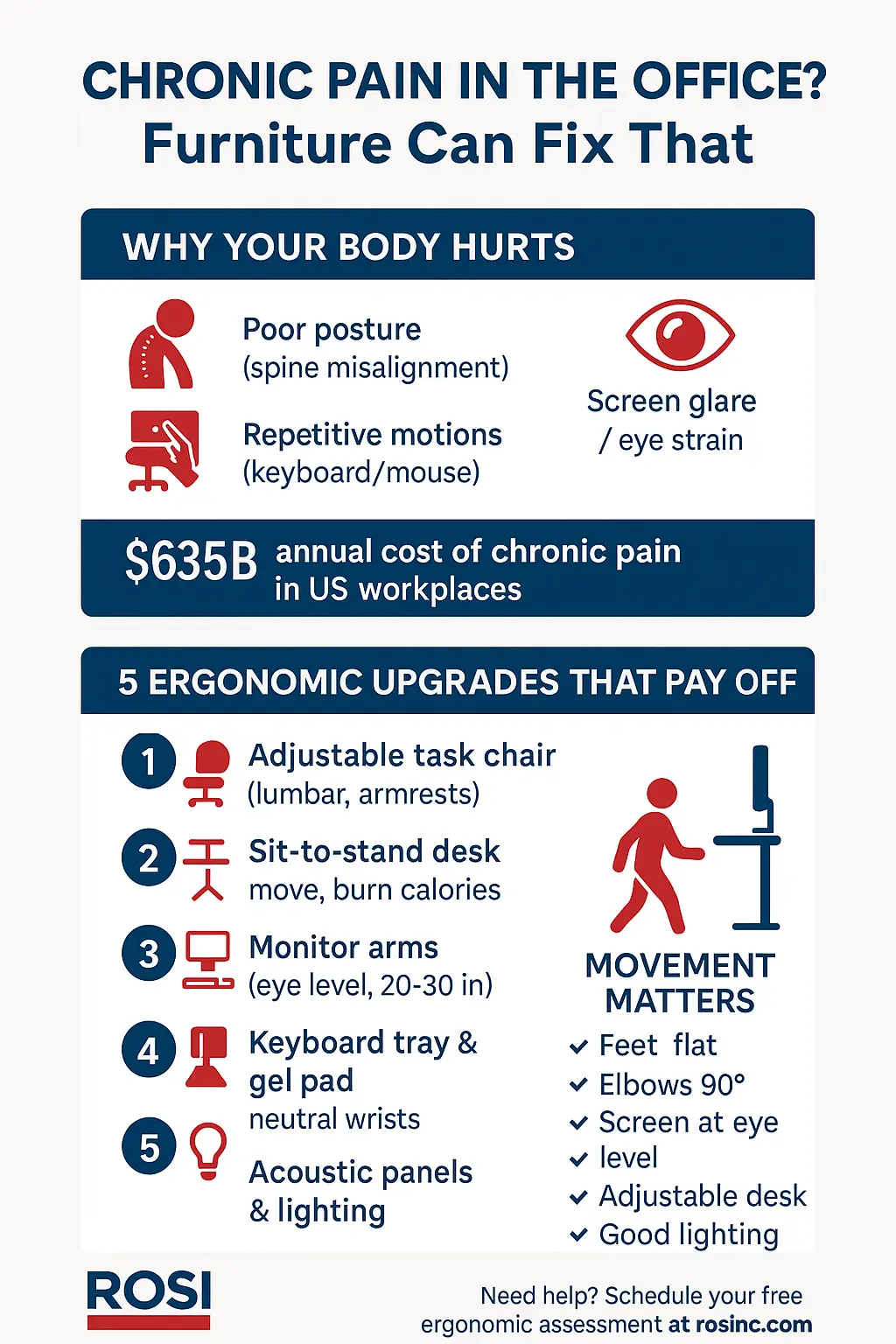
Chronic Pain in the Office? Office Furniture Can Fix That
Whether you work in an open office full of beanbags and espresso machines or rows of traditional office cubicles, chronic pain can still find you. The culprit is less where you sit than how you sit—and what you sit on. Poor posture, repetitive motions, and screen glare put relentless stress on joints, muscles, and eyes.
Good news: the right new office furniture plus a few healthy habits can stop the pain before it starts.

Why Chronic Pain Doesn’t Care About Your Floor Plan
Posture problems
Slouching shifts the spine out of alignment and loads the neck and lower back.
Repetitive motion
Thousands of tiny keyboard, mouse, and phone movements inflame wrists, forearms, and shoulders.
Visual strain
Leaning toward a dim or poorly placed monitor triggers headaches and mid-back aches.
Fast fact: The U.S. loses up to $635 billion a year in health costs and lost productivity linked to chronic pain.
Furniture First: 5 Ergonomic Upgrades That Pay Off
1. Adjustable Task Chairs
Lumbar support that follows the natural “S” curve of the spine
4-way armrests to keep shoulders relaxed
Waterfall seat edge to ease pressure behind the knees
2. Sit-to-Stand Desks
Change posture in under 10 seconds
Improve blood flow and burn 50–100 extra calories per hour
3. Monitor Arms
Keep screens at eye level and 20 – 30 inches away
Free desk space for documents and devices
4. Keyboard Trays & Gel Pads
Keep wrists neutral, reducing carpal-tunnel risk
Angle options for taller or shorter users
5. Acoustic Panels & Lighting
Softer light plus lower noise = fewer tension headaches
Panels double as modern visual dividers in open plans
Cubicle vs. Open Office: Tailoring the Fix
| Workspace Style | Common Pain Triggers | Furniture Solution |
|---|---|---|
| Cubicles | Static seated posture; cramped leg room | Compact sit-stand surfaces; high-back chairs with seat-depth sliders |
| Open Office | Screen glare, background noise | Adjustable task lighting, acoustic screens, and phone booths |
| Hybrid / Hot-desks | “One-size-fits-none” chairs | Borrow-friendly ergonomic chairs and height-adjustable benching |
Movement Matters—But Furniture Makes It Easy
Micro-breaks: Stand or walk for five minutes every 30.
Alternate positions: Program your sit-stand desk for automatic reminders.
Walk-and-talk: Swap a seated meeting for a two-lap stroll around the office.
Stretch station: A mat and foam roller in the corner invite quick mobility work.
Quick Checklist: Is Your Setup Protecting You?
Chair height lets feet rest flat
Elbows at 90° on the armrests
The screen sits at, or slightly below, eye level
Desk meets or moves with you (sit-stand)
Adequate task lighting with minimal glare
If you ticked fewer than four boxes, it’s time for an upgrade.
Internal Resources You Can Leverage Today
Explore our office furniture collection for proven ergonomic options that fit any layout.
Need chair inspiration? See the latest picks in “Say Goodbye to Back Pain: Houston’s Best Ergonomic Office Chairs”.
Conclusion
Chronic pain does not discriminate, but a well-designed workspace can. Pair smart office furniture with simple movement habits, and you’ll protect health, boost morale, and reclaim productivity—no matter if your team prefers cozy cubicles or the hustle of an open floor.
Ready to build a pain-free office? Contact ROSI for a free ergonomic assessment and custom space plan.

John Ofield is a recognized expert in the office furniture and office cubicle industry in Houston, TX, with over 40 years of experience. As the founder of ROSI Office Systems, he specializes in furniture space planning, custom cubicle designs, modern office chairs and tables, and high-quality commercial furniture. John’s expertise helps businesses enhance productivity and collaboration. He is also dedicated to mentoring entrepreneurs and redefining workspaces to inspire success.